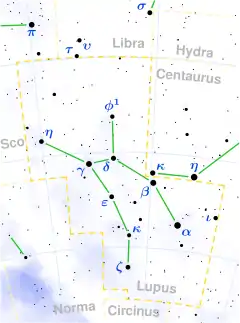Delta Lupi
Delta Lupi (δ Lupi, δ Lup) is a star in the southern circumpolar constellation of Lupus. In traditional Chinese astronomy, it is "the 2nd (star) of the Cavalry Officer" (騎官二). With an apparent visual magnitude of 3.22,[2] it is the fourth-brightest star in the constellation. The distance to this star has been measured using the parallax technique, yielding an estimate of roughly 900 light-years with a 15% margin of error.[1]
 | |
| Observation data Epoch J2000.0 Equinox J2000.0 | |
|---|---|
| Constellation | Lupus |
| Right ascension | 15h 21m 22.32168s[1] |
| Declination | –40° 38′ 51.0738″[1] |
| Apparent magnitude (V) | 3.22[2] |
| Characteristics | |
| Spectral type | B1.5 IV[3] |
| U−B color index | –0.910[4] |
| B−V color index | –0.224[4] |
| Variable type | β Cep[5] |
| Astrometry | |
| Radial velocity (Rv) | +0.2[6] km/s |
| Proper motion (μ) | RA: −19.49[1] mas/yr Dec.: −25.29[1] mas/yr |
| Parallax (π) | 3.69 ± 0.54[1] mas |
| Distance | approx. 900 ly (approx. 270 pc) |
| Absolute magnitude (MV) | –3.1[2] |
| Details | |
| Mass | 11.9 ± 0.2[7] M☉ |
| Radius | 6.1[8] R☉ |
| Luminosity | 10,000[7] L☉ |
| Surface gravity (log g) | 3.86[7] cgs |
| Temperature | 22,908[7] K |
| Metallicity [Fe/H] | –0.25 ± 0.11[9] dex |
| Rotational velocity (v sin i) | 230[10] km/s |
| Age | 15.4 ± 1.3[7] Myr |
| Other designations | |
| Database references | |
| SIMBAD | data |
The spectrum of this star matches a stellar classification of B1.5 IV,[3] which indicates this star has entered the subgiant stage and is in the process of evolving into a giant star. It is radiating around 10,000 times the luminosity of the Sun from its outer atmosphere at an effective temperature of 23,000 K, giving it a blue-white hue. This star has nearly 12 times the mass of the Sun and is roughly 15 million years old.[7]
Delta Lupi is a Beta Cephei variable star that undergoes periodic pulsations. It has a single period of variability lasting 0.1655 days, or six cycles per day.[5] This is a proper motion member of the Upper-Centaurus Lupus sub-group in the Scorpius-Centaurus OB association, the nearest such co-moving association of massive stars to the Sun.[2]
See also
References
- van Leeuwen, F. (November 2007). "Validation of the new Hipparcos reduction". Astronomy and Astrophysics. 474 (2): 653–664. arXiv:0708.1752. Bibcode:2007A&A...474..653V. doi:10.1051/0004-6361:20078357.
- de Geus, E. J.; de Zeeuw, P. T.; Lub, J. (June 1989), "Physical parameters of stars in the Scorpio-Centaurus OB association", Astronomy and Astrophysics, 216 (1–2): 44–61, Bibcode:1989A&A...216...44D
- Hiltner, W. A.; Garrison, R. F.; Schild, R. E. (July 1969), "MK spectral types for bright southern OB stars", Astrophysical Journal, 157: 313, Bibcode:1969ApJ...157..313H, doi:10.1086/150069
- Gutierrez-Moreno, Adelina; Moreno, Hugo (June 1968), "A photometric investigation of the Scorpio-Centaurus association", Astrophysical Journal Supplement, 15: 459, Bibcode:1968ApJS...15..459G, doi:10.1086/190168
- Smolec, R.; Moskalik, P. (May 2007), "Amplitude saturation in β Cephei models", Monthly Notices of the Royal Astronomical Society, 377 (2): 645–656, arXiv:astro-ph/0702406, Bibcode:2007MNRAS.377..645S, doi:10.1111/j.1365-2966.2007.11620.x
- Evans, D. S. (June 20–24, 1966), Batten, Alan Henry; Heard, John Frederick (eds.), The Revision of the General Catalogue of Radial Velocities, University of Toronto: International Astronomical Union, Bibcode:1967IAUS...30...57E
- Tetzlaff, N.; Neuhäuser, R.; Hohle, M. M. (January 2011), "A catalogue of young runaway Hipparcos stars within 3 kpc from the Sun", Monthly Notices of the Royal Astronomical Society, 410 (1): 190–200, arXiv:1007.4883, Bibcode:2011MNRAS.410..190T, doi:10.1111/j.1365-2966.2010.17434.x
- Underhill, A. B.; et al. (November 1979), "Effective temperatures, angular diameters, distances and linear radii for 160 O and B stars", Monthly Notices of the Royal Astronomical Society, 189: 601–605, Bibcode:1979MNRAS.189..601U, doi:10.1093/mnras/189.3.601
- Niemczura, E.; Daszyńska-Daszkiewicz, J. (April 2005), "Metallicities of the β Cephei stars from low-resolution ultraviolet spectra", Astronomy and Astrophysics, 433 (2): 659–669, arXiv:astro-ph/0410440, Bibcode:2005A&A...433..659N, doi:10.1051/0004-6361:20040396. Note: value taken from [m/H].
- Bernacca, P. L.; Perinotto, M. (1970). "A catalogue of stellar rotational velocities". Contributi Osservatorio Astronomico di Padova in Asiago. 239 (1). Bibcode:1970CoAsi.239....1B.
- "del Lup". SIMBAD. Centre de données astronomiques de Strasbourg. Retrieved 2007-01-18.